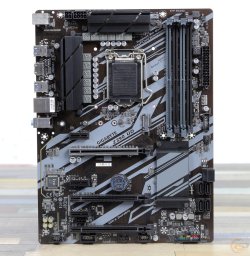- Joined
- Feb 22, 2022
- Messages
- 631 (0.51/day)
| Processor | AMD Ryzen 7 5800X3D |
|---|---|
| Motherboard | Asus Crosshair VIII Dark Hero |
| Cooling | Custom Watercooling |
| Memory | G.Skill Trident Z Royal 2x16GB |
| Video Card(s) | MSi RTX 3080ti Suprim X |
| Storage | 2TB Corsair MP600 PRO Hydro X |
| Display(s) | Samsung G7 27" x2 |
| Audio Device(s) | Sound Blaster ZxR |
| Power Supply | Be Quiet! Dark Power Pro 12 1500W |
| Mouse | Logitech G903 |
| Keyboard | Steelseries Apex Pro |
As have been said several times above, the only way to get an actual meaningful amount of working PCIE slots are workstation level hardware. Consumer hardware is not built for expandability anymore. And the CPU/Chipsets do not have enough available PCIE lanes for this to make much sense anyway. Things like USB4 controllers, 10Gb (or higher) NIC, M.2 nvme ssds, all require multiple PCIE lanes to work properly. So a miner motherboard with several x1 slots is not an option either.
You need to find a motherboard with built-in PCIE switch(es) which automatically increase the price by a good margin. See the MSi MEG X570S Unify-X MAX, that have one x16 and one x8 slot by default. But with numerous built-in switches it can provide up to 6 M.2 slots with x4 PCIE lanes each (1 M.2 is x4 from CPU, 1 is x4 from chipset, the other 4 are split from the physical x16 slots via switches). With some M.2 to PCIE slot adapters you can expand this alot. But the price for that motherboard alone is umm significant. But at least x4 M.2 slots have enough bandwidth for many potential upgrades.

You need to find a motherboard with built-in PCIE switch(es) which automatically increase the price by a good margin. See the MSi MEG X570S Unify-X MAX, that have one x16 and one x8 slot by default. But with numerous built-in switches it can provide up to 6 M.2 slots with x4 PCIE lanes each (1 M.2 is x4 from CPU, 1 is x4 from chipset, the other 4 are split from the physical x16 slots via switches). With some M.2 to PCIE slot adapters you can expand this alot. But the price for that motherboard alone is umm significant. But at least x4 M.2 slots have enough bandwidth for many potential upgrades.
Not much to work with when the CPU/chipsets don't have more PCIE lanes to begin with. At least the slots can physically hold x16 cardsThe only board that is somewhat modern there is the ASRock X570S PG Riptide and even that is gimped... three x16 slots but the lower two are electrically x4 and the bottommost one is limited to x2, WHY EVEN BOTHER FFS. Some of the other boards have an x16 and x8... but no USB-C internal connector.
That search is legitimately amazing though.







